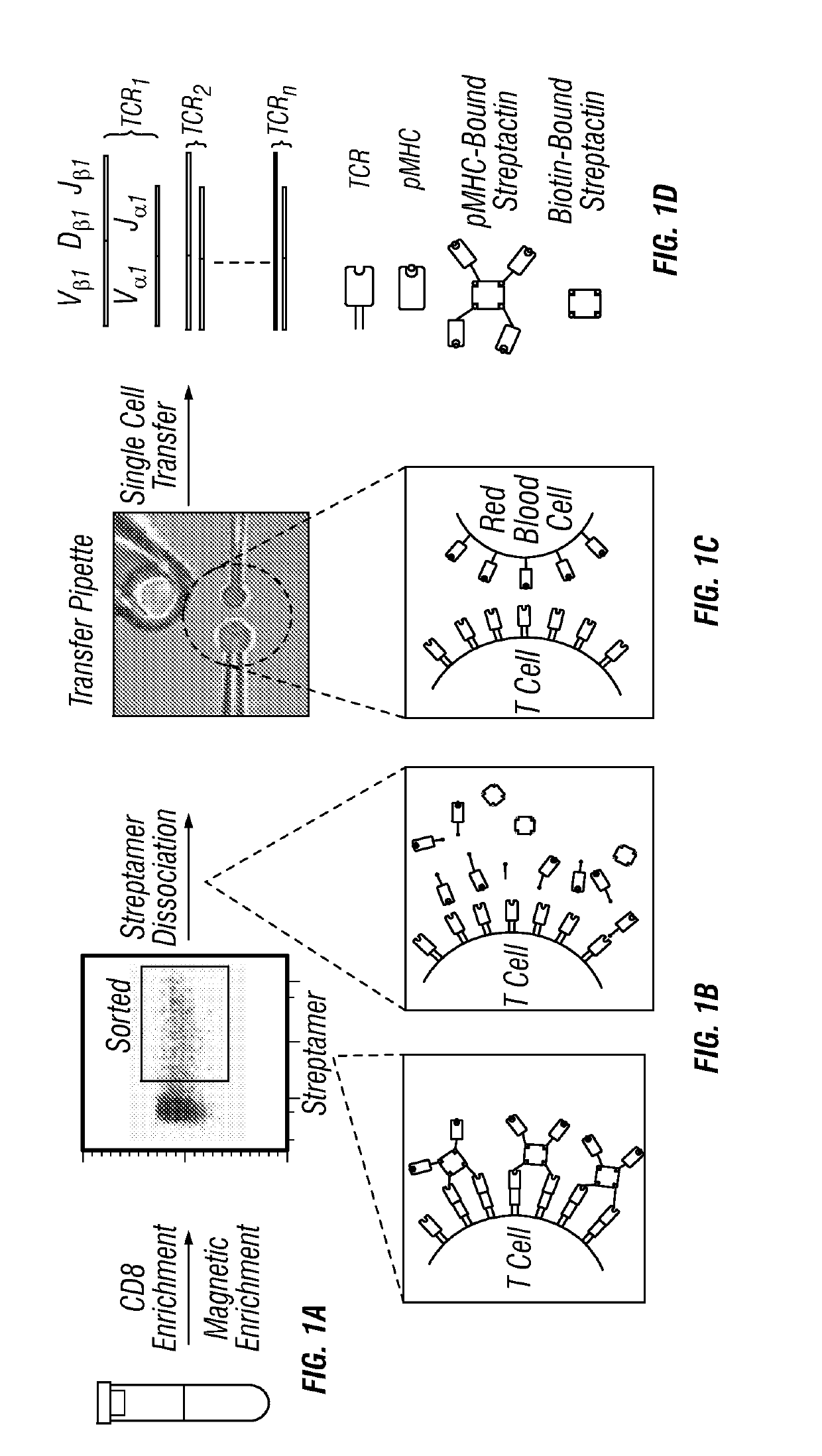Methods and compositions for detecting single t cell receptor affinity and sequence
a single t cell receptor and affinity technology, applied in the field of immunology and medicine, can solve the problems of inability to analyze large and polyclonal tcr repertoires, current plasmon resonance (spr) gold standard for measuring tcr-pmhc affinity, limited application of tcr-pmhc kinetics in primary human samples, etc., to prevent premature t cell activation
- Summary
- Abstract
- Description
- Claims
- Application Information
AI Technical Summary
Benefits of technology
Problems solved by technology
Method used
Image
Examples
example 1
Cell Receptor Affinity and Sequence Test (iTAST)
[0160]In order to solve issues with measuring TCR affinity, the in situ T cell receptor affinity and sequence test (iTAST) technology was developed to enable measurement of both TCR affinity and its sequence directly from primary CTLs. Starting from blood, TCR affinity and sequence for about 50 T cells can be determined in a day starting from as few as 75 antigen-specific CTLs. iTAST takes advantage of streptamers (Knabel et al., 2002) to reversibly label antigen-specific T cells and the recently-developed micropipette adhesion assay (Huang et al., 2010; Jiang et al., 2011) for measurement of two dimensional (2-D) TCR-pMHC binding affinity (FIG. 2A), which correlates better with T cell function than three-dimensional (3-D) affinity obtained in SPR5. The analysis was focused on CTLs because of their ability to directly kill target cells and their wide applications in cancer immunotherapy and persistent viral infections (Restifo et al., ...
example 2
n of iTAST in HCV-Specific CTLs
[0164]Having validated the iTAST method, it was next applied to study the rare HCV-specific CTL population within healthy HCV seronegative blood donors. Antigen-specific T cells are a heterogeneous populations of cells that recognize the same pMHC ligand using different TCRs generated by VDJ recombination (Yu et al., 2015; Moon et al., 2007). In pathogen naïve individuals, HCV-specific cells are extremely rare and are present in 1 in 105 to 106 CD8+ T cells, and are believed to be the safety net against infections and vaccination. However, the clonal lineage and affinity distribution of TCRs from this heterogeneous population of T cells have not been studied due to the lack of a proper technology. The common HCV epitope that binds to HLA-A2-ns3:1406-1415 (SEQ ID NO:1 KLVALGINAV) (Cerny et al., 1995) (hereafter referred to as HCV-specific T cells) was used. HCV-specific T cells from donors 1-3 with ages of 62, 49, and 33, respectively, were isolated and...
example 3
Affinity for Cell Function
[0168]Given the potential of iTAST in immune monitoring and adoptive T cell transfer in cancer, it was next determined whether 2D affinity measured by iTAST is a predictor of cell function. 43 HCV-specific CTLs were in vitro expanded into clones and assessed for functionality by their capacity to kill JY target cells pulsed with HCV peptide. All clones bound specifically and above background adhesion levels to HCV peptide-loaded pMHC in the 2D affinity measurement. It was found that 2D affinity correlated significantly with lysis capacity, with the threshold of functionality beginning at a 2D affinity of about 2×105 um4, which translates to a requirement of about 1200 pMHCs for T cell activation (FIG. 5B, 5C). It was interesting that donor 3, the youngest donor at 33 years of age, contained significantly more cells above this affinity threshold compared to cells from donors 1 and 2, who are older at 49 and 62 respectively, which contained more cells below t...
PUM
| Property | Measurement | Unit |
|---|---|---|
| temperature | aaaaa | aaaaa |
| affinity | aaaaa | aaaaa |
| micropipette adhesion assay | aaaaa | aaaaa |
Abstract
Description
Claims
Application Information
 Login to View More
Login to View More - R&D
- Intellectual Property
- Life Sciences
- Materials
- Tech Scout
- Unparalleled Data Quality
- Higher Quality Content
- 60% Fewer Hallucinations
Browse by: Latest US Patents, China's latest patents, Technical Efficacy Thesaurus, Application Domain, Technology Topic, Popular Technical Reports.
© 2025 PatSnap. All rights reserved.Legal|Privacy policy|Modern Slavery Act Transparency Statement|Sitemap|About US| Contact US: help@patsnap.com



